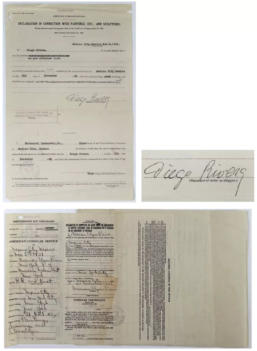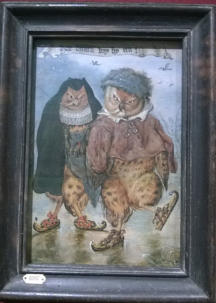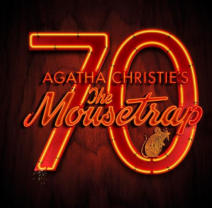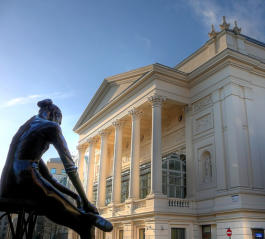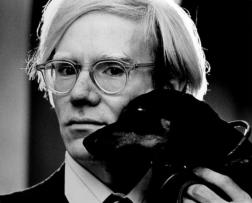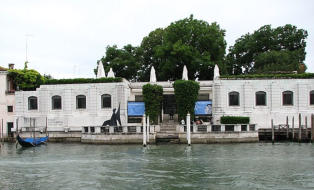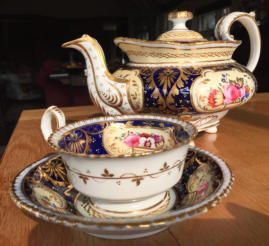The Arts Society Rutland

New Membership year 2026
Meetings take place at the Uppingham Town Cricket Club, Castle Hill, Leicester Road
Uppingham, LE15 9SP at 11am please be seated before then.
Coffee will be available from 10.15 with Hugh the Membership Secretary ready at the
desk to welcome you, as you come in and register.
January 15th 2026
Jacky Klein
A Picture a Day': Peggy Guggenheim and the Birth of Mid-Century Modernism
This is the story of how the socialite and muse Peggy Guggenheim became one of the
greatest collectors in the history of modern art.
Friends with the leading cultural figures of her day – including Cecil Beaton, Jean
Cocteau, Barbara Hepworth, Scott Fitzgerald, Ian Fleming, Djuna Barnes and Igor
Stravinsky – she was photographed by Man Ray and André Kertesz, took advice from
Marcel Duchamp and married – among others
– the artist Max Ernst.
She moved with ease between the social elites
of New York and the bohemia of Paris. This
talk asks why it was that – seemingly out of
the blue – Guggenheim started collecting
contemporary art in the 1930s?
Peggy Guggenheim Home on the Grand Canal
Venice. IslandsEnd. Creative Commons
Attribution 3.0
February 19th 2026
Emma Johnson
Comedy Classical
In this hour long talk we look at snippets of the classical cannon from Mozart's A
Musical Joke and Saint-Saens' Carnival of the Animals, to Malcolm Arnold's Grand
Overture for Three Vacuum Cleaners, a Floor Polisher and Four Rifles, taking in along
the way footage of Charlie Chaplin, Dudley Moore and Victor Borge, to uncover the
techniques composers use to make us chortle.
Emma Johnson is a clarinettist and was a young musician of the year. She joined the
National Youth Orchestra of Great Britain at the age of 15. In 1984, she won the BBC
Young Musician of the Year title, performing Crusell's Second Concerto with the BBC
Philharmonic Orchestra under Bryden Thomson.
March 19th 2026
Mariska Beekenkamp-Wladimiroff
The Art of Laughter
Seldom did one country produce so many comical paintings as
the Netherlands did during the Dutch Golden Age.
People and animals misbehaving, being silly, naughty and
laughing out loud can be seen in unprecedented numbers on
Dutch Baroque genre paintings. Some of these paintings were
visual representations of common sayings or depictions of
stock characters in contemporary plays, while others were
created as moral lessons. However, the fashion for these type
of paintings also coincided with a belief by contemporary
doctors that laughing was good for your health, and a boom in
the publications of books with jokes and funny poems.
Adriaen van de Venne 1604 - 1662 - How Well We Go Together
Jane023 Public domain
April 16th 2026
Benedict Morrison
Caught in the Mousetrap- the theatrical World of Agatha Christie
Despite being the longest running play in the history of theatre,
The Mousetrap is often treated with critical contempt. It is seen
as a tourist attraction rather than serious theatre.
This talk challenges this assumption and explores Christie as a
theatrical experimenter, an innovator who played as many tricks
with theatre audiences as she did with the readers of her novels.
It also explores how significant theatrical metaphors recur
throughout her fiction. Murder is rarely grizzly, often unrealistic,
and always a performance.
May 21st 2026
Lydia Bauman
Painting the Modern Garden - from Monet to Matisse
Monet, perhaps the most important painter of gardens in the history of art, once said
that he owed his painting "to flowers". But there were so many other artists who not
only created their own gardens, but made them into the subject of their work - among
them, Pissarro, Liebermann, Sargent, Sorolla, Tissot, Kandinsky, Klee, Van Gogh, Klimt
and Matisse.
The modern garden, changed by 19th century innovations such as hybridisation, the
use of glasshouses and foreign exploration, was part and parcel of a period of great
social change and the changing face of modern cities to which artists responded from
the 1860s onwards.
June 18th 2026
Christopher Garibaldi
Time for Tea - A History of British Teapots and Tea
This lecture serves as an introduction to the teapot collection at Norwich Castle
Museum which has the largest specialist collection of
British ceramic teapots in the world, housed in the Twining
Teapot Gallery.
It looks at the changing role of tea from its introduction in
the 17th century as a fashionable and expensive drink of
great exoticism associated with courtly and aristocratic
circles through to its eventual position at the centre of the
British psyche as the ‘national drink’.
This lecture also examines the development of the teapot
as it reflects the technological advances and developments
of general British ceramic history.
1830s neo-rococo teapot and tea cup ImageChristopher Garibaldi
There are no meetings in July and August
September 17th 2026
Lucrezia Walker
Andy Warhol
Pioneer of Pop Art, his New York studio, The Factory, was
the place to be in the 1960s and ‘70s.
Illustrator, printer, filmmaker, manager of rock band The
Velvet Underground, founder of Interview magazine,
author of numerous books, creator of iconic pop images
of Marilyn, Jackie and Elvis, soup can and coke bottle,
and coiner of the expression ‘15 minutes of fame’
Warhol’s own fame continues long after his death, as
Prince of Pop Art.
Andy Warhol with Archie, his pet Dachshund. Jack Mitchell
Creative Commons Attribution-Share Alike 4.0
October 15th 2026
Deborah Jenner
Monet's French Impressionism: What He Sees is What We Get
Monet left behind academic rules and
preconceived ideas about art to capture his
actual visual experience.
He wouldn’t deviate from what he really saw.
Indeed the sun’s angle, local weather and tides
recorded in his Impression Sunrise provide proof
for recent studies to pinpoint the date, time and
place it was painted. He wanted the viewers to
share what he was seeing and feeling.
He limited information to blotches of pure colour
- keeping tonalities to a minimum and avoiding all outlines - so that the brain
interprets his canvases in a purely emotional way. We distinguish forms and shadows
amongst his mosaic of hues thanks to the complementary colours.
100th anniversary of death 5 December 1926.
Meadow at Giverny Morning Effect,
Claude Monet Public domain
November 19th 2026
Will Gilding
Pricing Provenance
What turns a humble typewriter into an
international must have? A scrap of a police
charge sheet into something collectors go potty
for? Or even a pair of old stockings from a £1
charity shop find to £1,100 at auction? The
answer is it comes down to provenance.
This lecture will look at the almost incalculable
factor of past ownership, and the effects on
auction value.
Diego Rivera, Frida Kahlo
"Diego Rivera's SIGNED MoMA Exhibition
Shipping/Inventory Contract", 1931, Museum
Modern Art NY
New Membership year
January 21st 2027
Simon Whitehouse
Columns, Cabbages and Kings. A Short History of Covent Garden
In this lecture, we chart the highs (and lows) of one of
London’s most vibrant and fascinating neighbourhoods.
We begin with the area’s surprising Saxon origins to its
takeover by the monks at Westminster Abbey. Following
the Reformation, the area changed hands again and in the
early Stuart era the first planned square was developed
by the Earls of Bedford and architect Inigo Jones.
By 1670, the area was inextricably linked to the theatre
and a daily market was established which thrived until
1974.
The Royal Opera House, Bow Street frontage, with the statue of Royal Ballerina Katie Pianoff in the
foreground, Russ London Creative Commons Attribution-Share Alike 3.0
18 February 2027
Russell Nash
The Men Who Made Menswear
This lecture tells the story of men's tailoring over the past 200 years, told through the lives of
the men who commissioned and created and wore it.
Tailors, shirt-makers, hatters and other craftspeople in
London’s west end, especially around Savile Row & Jermyn
Street have shaped the way men dress since the Regency.
How did men such as Beau Brummell, The Duke of Windsor,
Tommy Nutter, Montague Burton, Alexander McQueen and
John Stephen create their signature looks which influenced
the mens fashion?
This lecture also looks at the wider cultural shifts since the
early 19th century to the present day and how they affected
the way that men present themselves.
Savile Row- Tailoring at Henry Poole and Co., London, 1944
Ministry of Information Photo Division Photographer, Public domain
18 March 2027
Hilary Williams
The Wallace and Frick Collections and their connection with Knole
Details later
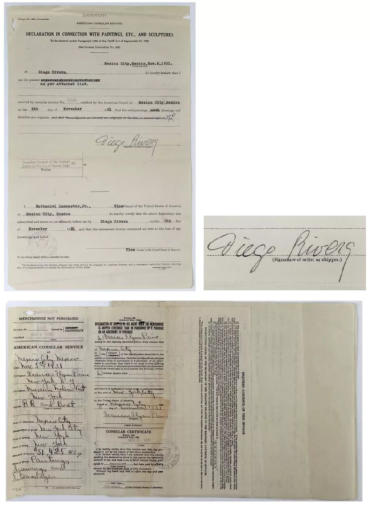
Web site and mobile phone pages created and maintained
by Janet Groome, Handshake Computer Training
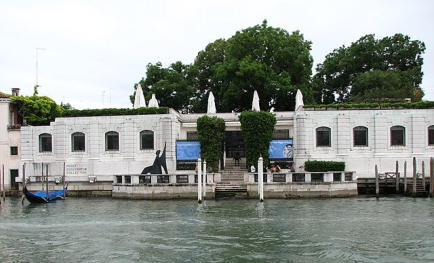
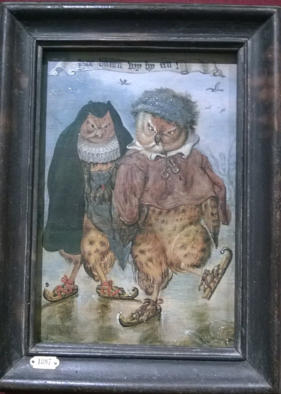
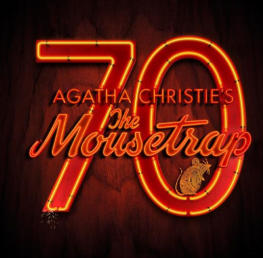
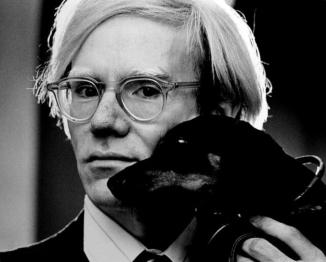
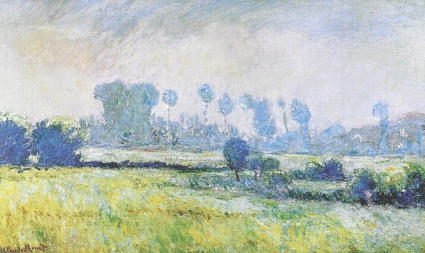
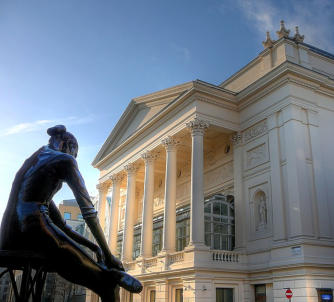
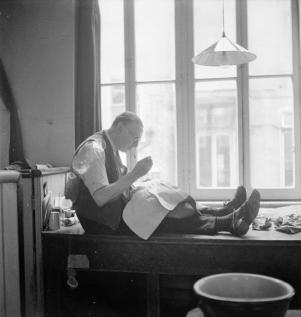
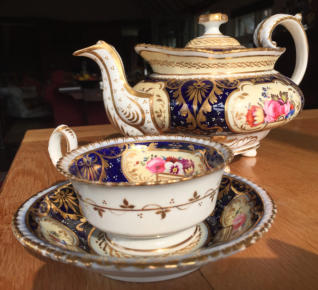
Web site and mobile phone pages designed, created and
maintained by Janet Groome Handshake Computer Training
Meetings take place at the Uppingham Town
Cricket Club, Castle Hill, Leicester Road
Uppingham, LE15 9SP at 11am please be
seated before then.
Coffee will be available from 10.15 with Hugh
the Membership Secretary ready at the desk
to welcome you as you come in and register
New membership year 2026
January 15th 2026
Jacky Klein
A Picture a Day': Peggy Guggenheim and
the Birth of Mid-Century Modernism
This is the story of how the socialite and
muse Peggy Guggenheim became one of the
greatest collectors in the history of modern
art.
Friends with the leading cultural figures of her
day – including Cecil Beaton, Jean Cocteau,
Barbara Hepworth, Scott Fitzgerald, Ian
Fleming, Djuna Barnes and Igor Stravinsky –
she was photographed by Man Ray and André
Kertesz, took advice from Marcel Duchamp
and married – among others – the artist Max
Ernst.
She moved with ease between the social
elites of New York and the bohemia of Paris.
This talk asks why it was that – seemingly out
of the blue – Guggenheim started collecting
contemporary art in the 1930s?
Peggy
Guggenheim
Home on the
Grand Canal
Venice.
IslandsEnd.
Creative
Commons
Attribution 3.0
February 19th 2026
Emma Johnson
Comedy Classical
In this hour long talk we look at snippets of
the classical cannon from Mozart's A Musical
Joke and Saint-Saens' Carnival of the
Animals, to Malcolm Arnold's Grand Overture
for Three Vacuum Cleaners, a Floor Polisher
and Four Rifles, taking in along the way
footage of Charlie Chaplin, Dudley Moore and
Victor Borge, to uncover the techniques
composers use to make us chortle.
Emma Johnson is a clarinettist and was a
young musician of the year. She joined the
National Youth Orchestra of Great Britain at
the age of 15. In 1984, she won the BBC
Young Musician of the Year title, performing
Crusell's Second Concerto with the BBC
Philharmonic Orchestra under Bryden
Thomson.
March 19th 2026
Mariska Beekenkamp-Wladimiroff
The Art of Laughter
Seldom did one country produce so many
comical paintings as the Netherlands did
during the Dutch Golden Age.
People and animals
misbehaving, being silly,
naughty and laughing
out loud can be seen in
unprecedented numbers
on Dutch Baroque genre
paintings. Some of these
paintings were visual
representations of
common sayings or
depictions of stock
characters in
contemporary plays,
while others were created as moral lessons.
However, the fashion for these type of
paintings also coincided with a belief by
contemporary doctors that laughing was good
for your health, and a boom in the
publications of books with jokes and funny
poems.
Adriaen van de Venne 1604 - 1662 -
How Well We Go Together
Jane023 Public domain
April 16th 2026
Benedict Morrison
Caught in the Mousetrap- the theatrical
World of Agatha Christie
Despite being the
longest running play in
the history of theatre,
The Mousetrap is often
treated with critical
contempt. It is seen as
a tourist attraction
rather than serious
theatre.
This talk challenges this assumption and
explores Christie as a theatrical experimenter,
an innovator who played as many tricks with
theatre audiences as she did with the readers
of her novels.
It also explores how significant theatrical
metaphors recur throughout her fiction.
Murder is rarely grizzly, often unrealistic, and
always a performance.
May 21st 2026
Lydia Bauman
Painting the Modern Garden - from Monet
to Matisse
Monet, perhaps the most important painter of
gardens in the history of art, once said that
he owed his painting "to flowers". But there
were so many other artists who not only
created their own gardens, but made them
into the subject of their work - among them,
Pissarro, Liebermann, Sargent, Sorolla,
Tissot, Kandinsky, Klee, Van Gogh, Klimt and
Matisse.
The modern garden, changed by 19th century
innovations such as hybridisation, the use of
glasshouses and foreign exploration, was part
and parcel of a period of great social change
and the changing face of modern cities to
which artists responded from the 1860s
onwards.
June 18th 2026
Christopher Garibaldi
Time for Tea - A History of British
Teapots and Tea
This lecture serves as an introduction to the
teapot collection at Norwich Castle Museum
which has the largest specialist collection of
British ceramic teapots in the world, housed
in the Twining Teapot Gallery.
It looks at the
changing role of
tea from its
introduction in the
17th century as a
fashionable and
expensive drink of
great exoticism
associated with
courtly and
aristocratic circles
through to its eventual position at the centre
of the British psyche as the ‘national drink’.
This lecture also examines the development
of the teapot as it reflects the technological
advances and developments of general British
ceramic history.
1830s neo-rococo teapot and tea cup
ImageChristopher Garibaldi
September 17th 2026
Lucrezia Walker
Andy Warhol
Pioneer of Pop Art, his New York studio, The
Factory, was the place to be in the 1960s and
‘70s.
Illustrator, printer,
filmmaker, manager
of rock band The
Velvet Underground,
founder of Interview
magazine, author of
numerous books,
creator of iconic pop
images of Marilyn, Jackie and Elvis, soup can
and coke bottle, and coiner of the expression
‘15 minutes of fame’ Warhol’s own fame
continues long after his death, as Prince of
Pop Art.
Andy Warhol with Archie, his pet Dachshund.
Jack Mitchell
Creative Commons Attribution-Share Alike 4.0
October 15th 2026
Deborah Jenner
Monet's French Impressionism: What He
Sees is What We Get
Monet left behind academic rules and
preconceived ideas about art to capture his
actual visual experience.
He wouldn’t deviate from what he really saw.
Indeed the sun’s angle, local weather and
tides recorded in his Impression Sunrise
provide proof for recent studies to pinpoint
the date, time and place it was painted. He
wanted the viewers to share what he was
seeing and feeling.
He limited information to blotches of pure
colour - keeping tonalities to a minimum and
avoiding all outlines - so that the brain
interprets his canvases in a purely emotional
way. We distinguish forms and shadows
amongst his mosaic of hues thanks to the
complementary colours.
100th anniversary of death 5 December 1926.
Meadow at Giverny Morning Effect,
Claude Monet Public domain
November 19th 2026
Will Gilding
Pricing Provenance
What turns a humble typewriter into an
international must have? A scrap of a police
charge sheet into something collectors go
potty for? Or even a pair of old stockings from
a £1 charity shop find to £1,100 at auction?
The answer is it comes down to provenance.
This lecture will look at the almost
incalculable factor of past ownership, and the
effects on auction value.
Diego Rivera, Frida Kahlo
"Diego Rivera's SIGNED MoMA Exhibition
Shipping/Inventory Contract", 1931, Museum
Modern Art NY
New Membership year
January 21st 2027
Simon Whitehouse
Columns, Cabbages and Kings. A Short
History of Covent Garden
In this lecture, we
chart the highs
(and lows) of one
of London’s most
vibrant and
fascinating
neighbourhoods.
We begin with the
area’s surprising
Saxon origins to
its takeover by the monks at Westminster
Abbey. Following the Reformation, the area
changed hands again and in the early Stuart
era the first planned square was developed by
the Earls of Bedford and architect Inigo Jones.
By 1670, the area was inextricably linked to
the theatre and a daily market was
established which thrived until 1974.
The Royal Opera House, Bow Street frontage, with the
statue of Royal Ballerina Katie Pianoff in the
foreground, Russ London Creative Commons
Attribution-Share Alike 3.0
18 February 2027
Russell Nash
The Men Who Made Menswear
This lecture tells the story of men's tailoring over
the past 200 years, told through the lives of the
men who commissioned and created and wore it.
Tailors, shirt-
makers, hatters
and other
craftspeople in
London’s west
end, especially
around Savile
Row & Jermyn
Street have
shaped the way
men dress since
the Regency.
How did men
such as Beau
Brummell, The Duke of Windsor, Tommy Nutter,
Montague Burton, Alexander McQueen and John
Stephen create their signature looks which
influenced the mens fashion?
This lecture also looks at the wider cultural shifts
since the early 19th century to the present day
and how they affected the way that men present
themselves.
Savile Row- Tailoring at Henry Poole and Co., London,
1944
Ministry of Information Photo Division Photographer,
Public domain
18 March 2027
Hilary Williams
The Wallace and Frick Collections and their
connection with Knole
Details later
